Service History
On a spring day in 1867, shipbuilder John Martel looked on with pride as the schooner
Kate Kelly slid into the water at Tonawanda, New York. Described by a contemporary newspaper as being “of medium size . . . good model and general build,” the schooner possessed two masts, a square stern, a figurehead bow, and measured 126 feet long, 26 feet wide, and 10 feet deep. Its primary cargo would be grain, but the schooner could efficiently carry coal, iron ore, wood products, or any other low-cost bulk cargo.
During a career that spanned 28 years, the
Kate Kelly had several owners, most of them associated with the Lake Ontario trade. It was a canaller, one of hundreds of vessels built to fit through the locks of the second Welland Canal, the narrow artificial river that connected distant Lake Ontario with the other Great Lakes below Niagara Falls. Most of the canal locks were just 26 ½ feet wide, 150 feet long, and 9 feet deep. This left the Kate Kelly with less than four inches of clearance on either side when transiting the canal.
John Martel built the
Kate Kelly for Lewis Ryerse, a Buffalo ship owner. The vessel changed hands several times soon after it was built, until James Keller, Edward W. Parmalee, and Captain Robert Hayes bought it September 30, 1867. Captain Hayes, who had only a one-eighth share in the vessel, took command, a post he would hold for nine years. The three owners changed the vessel’s homeport from Buffalo to Oswego, New York, the most important U.S. port on Lake Ontario. The
Kate Kelly would call Oswego home for the next twenty-five years.
Hayes and his associates employed the
Kate Kelly to carry grain from western Michigan ports, particularly Chicago, to Lake Ontario ports, most commonly Oswego and Kingston, Ontario. The vessel could hold 18,000 bushels of corn and over 19,000 bushels of wheat. Sailing west from Lake Ontario, the schooner frequently carried coal and occasionally picked up odd cargoes such as railroad iron. The schooner sometimes made the westbound trip light, depending upon a good grain charter to make a profit.
The
Kate Kelly suffered hard use while under the command of Captain Hayes. Newspapers, wreck lists, and admiralty court records report eight accidents and allude to others involving the
Kate Kelly between 1869 and 1877. The schooner sustained major damage in at least two of these incidents. In 1869, the vessel grounded near Cheboygan, Michigan, and the schooner’s entire cargo of wheat was reportedly lost. The Classification of Lake Vessels and Barges insurance register noted that the
Kate Kelly had undergone large repairs in 1870 and gave it just an A2 rating, an indication that the vessel was not in top condition for her age. In April 1871, the vessel collided with the brig Rosius near the Eighteenth Street Bridge at Chicago. In April 1874, it hit a dock at Oswego. Two months later, the battered vessel sprung a leak while transiting the Welland Canal. The
Kate Kelly rounded out the year by grounding at Ford’s Shoal on Lake Ontario in November. Collectively, the number and severity of the accidents call into question Captain Hayes’ competence.
The year 1875 began better for Captain Hayes and the
Kate Kelly. Research has turned up no reports of accidents for most of the season. In late September, however, the vessel fetched up on shore about 100 feet outside of the East Pier at Oswego. It had been running light on a trip from Kingston, Ontario, and a stiff northwest wind had built up a large sea. By the time the
Kate Kelly attempted to enter the port, the wind had shifted to the southwest and nearly died out. Whether Hayes misjudged the wind direction or was surprised by its sudden moderation is unknown, but the vessel lost headway. Heavy seas carried the helpless schooner onto the beach and deposited its broadside onto a hard bottom. The crew abandoned the ship, leaving it to pound on the beach throughout the night. By morning, a local newspaper reported that the
Kate Kelly had broken its back, sprung its decks, and had been holed.
Saving the schooner initially seemed doubtful. Had the vessel grounded as severely on a more distant beach, it would have certainly proved a total loss. The
Kate Kelly, however, was insured for $12,000, and Oswego possessed first-class ship salvage and repair capabilities. Insurance inspector Captain Berriman hired the well-known shipbuilder George Goble, who also built the
Daniel Lyons, to assist the salvors in removing the vessel from the beach. Goble and his partner, James D. McFarlane, operated one of the best-equipped shipyards on Lake Ontario. Using two powerful tugs, screw-jacks, and other implements, the salvors released
Kate Kelly from the beach. On September 30, 1875, the Goble-built tug
Alanson Sumner managed to pull the schooner into the harbor, but it sank upon arrival. Three days, three steam pumps, and two canal boats later, the
Kate Kelly floated again – this time just long enough to move it to the entrance to the Ontario Dry Dock, home of the Goble and McFarlane yard, where it sank again.
As earlier reports had indicated, the
Kate Kelly had sustained substantial damage. The keelson was broken aft of the centerboard trunk, several floor timbers were broken, and the starboard side had so many holes it presented “the appearance of a sieve.” At first, the insurance appraisers could not agree on an estimated cost for repairs. An early observer predicted more than $6,000, while others suggested that the total bill, including salvage costs, would exceed the $12,000 for which the vessel was insured. Ultimately, Goble and McFarlane installed floor timbers, a new keel, and replanked the starboard side’s entire bottom and some of the port side. They installed some new ceiling planking, pocket pieces on the centerboard trunk, and a new deck. The yard also lengthened her bowsprit and added an additional jib. These additions to the headgear may have been intended to improve the ship's handling. In any case, the vessel had only one more known collision after the yard altered its rig. It is unclear who paid for the
Kate Kelly's repair, but Captain Hayes and his current partners retained their ownership.
The
Kate Kelly’s many accidents raise questions about its management, which was rather fluid, to put it mildly, during the Robert Hayes era. Charles Parker, who, according to the enrollments, owned the largest share of the vessel during the mid-1870s, died during the summer of 1874. The family’s small shipbroker business fell into the hands of Parker’s son. When the elder Parker died, the owners should have applied for a new enrollment for the
Kate Kelly. They did not, an omission that suggests sloppy or possibly dishonest business practices.
The poor management eventually caught up with the
Kate Kelly’s owners. On October 22, 1877, William H. Wolf and Thomas Davidson, operators of a large Milwaukee shipyard, filed a libel suit against the schooner for non-payment of debts. Wolf and Davidson contended that they were owed $875 plus interest for repairs and supplies they provided to the vessel in October 1876. At the time of its arrest, the
Kate Kelly was at Cleveland, recovering from yet another mishap. On October 13, the schooner was carrying 380 tons of iron ore from Ogdensburg to Cleveland and ran aground on a sandbar. To float the vessel free, the crew threw fifty tons of ore, worth well over $200, into the lake. The procedure in this situation involved arresting the vessel and, if payment was not made, selling it at a federal pubic auction, popularly called a Marshal Sale.
Captain Hayes, court records reveal, had left a long stack of unpaid bills in Milwaukee and Chicago. When notice of
Kate Kelly’s arrest appeared in the newspapers, six other creditors presented bills. The sum total for action, including court costs, totaled $5,580, a figure considerably more than the schooner’s value. The largest claim against the vessel, $3,735, came from Goble and McFarlane, the shipbuilders who had rebuilt
Kate Kelly two years before. The Wolf and Davidson claim, including interest, came to $927. Other bills were presented for ship equipment, groceries and supplies, trimming (loading) a cargo of grain, and for the recently jettisoned iron ore. With pending bills far higher than the
Kate Kelly’s value, its owners made no effort to pay off the creditors.
Court records suggest that problems plagued the
Kate Kelly partnership. The younger Parker, half owner, appears to have been insolvent by this time, and Henry W. Green, owner of a quarter share of the schooner, indicated that “he might secure his own interest, but would do nothing to benefit Parker.” For his part, Captain Hayes, who owned the final quarter of the vessel, admitted that the claims against the vessel were just and accurate but indicated that he was “unwilling and unable” to pay the creditors. The vessel went on the auction block on November 6, 1877, and sold to George Goble and James McFarlane for $3,000.
The
Kate Kelly’s new owners had little in common with Robert Hayes and his associates. The Ireland-born Goble was one of Lake Ontario’s most respected shipbuilders and had been a fixture on the Oswego waterfront since the late 1830s. McFarlane’s father-in-law was F.G. Carrington, Oswego’s most prosperous businessman. The two successfully managed the
Kate Kelly for more than fifteen years. During the 1880s and early 1890s, the
British Whig, a Kingston newspaper, intermittently recorded the schooner’s travels, cargoes, and occasional problems. During the Goble and McFarlane era, the
Kate Kelly made frequent trips carrying corn or wheat between Chicago and Kingston.
Even under solid management, sailing ships on the Great Lakes faced constant dangers. The potential for problems mounted as ships aged. In September 1881, the
Kate Kelly lost its fore boom during a storm. Five years later, in 1886, part of the foremast and the main topmast tore away during a June squall. Later that summer, the aging vessel discharged 8,500 bushels of wet wheat, a sure sign of hull problems. Major groundings, a frequent occurrence on the
Kate Kelly under Captain Hayes, appear to have happened only once during the Goble and McFarlane years. On November 13, 1882, the vessel ran aground during a blow on Lake Ontario. A rescue party that included 30 men and a powerful tug lightered 5,000 bushels of wheat from the schooner and pulled it from the shore. In 1890 in Detroit, James O’Hara, a forty-year-old sailor from Rochester, died when he fell from the main boom on the
Kate Kelly while furling a sail.
In March 1893, a new owner took possession of the
Kate Kelly. Captain Hartley J. Hatch of Chicago had commanded sail and steam vessels on the Great Lakes for nearly twenty years. Well-connected in the shipping world and highly respected among his peers, Hatch seemed well suited to wring profits out of the old schooner.
Despite its decline as a port city in the 1890s, Chicago remained the “schooner city.” A growing industrial giant, Chicago’s demand for raw materials, including iron ore, coal, and wood products, and its importance as a grain port supported a large-scale maritime trade. With his connections, Hatch may have been well positioned to get good charters for the old, but operationally inexpensive,
Kate Kelly.
On October 28, 1893, the
Kate Kelly had run ashore on Spider Island, one of the many obstacles that made the Death’s Door Passage between Green Bay and Lake Michigan so hazardous. At the time, the vessel was carrying a heavy cargo of grindstones from Grindstone City, Michigan, to Milwaukee and suffered significant damage. The
Door County Advocate noted that the vessel’s cargo, worth $10,000, was “far too valuable to risk out in an old leaky vessel at this season of the year.”
Final Voyage
As schooners aged, inevitable leaks jeopardized cargoes of grain and iron. However, leaky vessels could still carry wood, a cargo not easily damaged by exposure to water. Furthermore, soft woods could provide enough buoyancy to keep a flooded schooner afloat. Carrying wood, however, did not save the
Kate Kelly. In May 1895, the ship left Alpena, Michigan, with a load of hemlock railroad ties and perhaps other wood products. The schooner stopped at Sheboygan, Wisconsin, before proceeding down the lake for Chicago.
On Monday morning, May 13, 1895, a vicious spring storm exploded across Lake Michigan, catching the
Kate Kelly and sinking it. It is not known what specifically caused the loss, but local farmers reported observing a schooner capsize near where the
Kate Kelly was later found. The storm was particularly severe: several vessels sank, and many others suffered significant damage. On Tuesday, May 14, 1895, a Kenosha-based tug brought in wreckage that clearly confirmed that the
Kate Kelly had gone down.
The following day, the local U.S. Lifesaving Service crew spied a mast protruding several feet from the water. Resting in 60 feet of water, the wreck ultimately proved to be the
Kate Kelly. On June 9, 1895, diver John Harms explored parts of the wreck and reported that the jib boom and bowsprit were intact. The foremast was gone; its broken remains may have been removed by early salvors to reduce the wreck’s threat to other vessels. One anchor had been cast overboard, and the mizzenmast was enveloped in a tangle of rigging. Harms found no bodies but brought up a large section of a flag that had been placed at half-mast in the forward rigging, perhaps a futile attempt at a distress signal. Given the eyewitness account, the distress flag, and the reported condition of the wreck, it seems likely that the
Kate Kelly had battled the weather for some time. The end, however, came quickly, with the vessel either capsizing or plunging to the bottom after large seas swept the deck with enough force to tear off the cabin, yawl boat, monkey rails, and anchor.
Today
The
Kate Kelly wreck site is marked seasonally by an official state shipwreck buoy placed by the Wisconsin Historical Society at 42° 46.684' N, 087° 43.509' W.
The lower hull, or bilge, is the largest hull section. The hull contains 52 double frame sets extant to the turn of the bilge. Two planks from the base of the centerboard trunk remain attached to the keelson, but the remaining trunk box lies intact 12 feet off the lower hull’s port side. A fragment of the centerboard is visible within the keelson's centerboard slot. The remainder of the centerboard lies adjacent to the lower hull’s starboard side. The centerboard is broken cleanly in two, with the upper half lodged in the keelson and the lower half laying to starboard of the hull. This suggests that Captain Hatch had the centerboard fully deployed at the time of loss, and it was snapped off when the
Kate Kelly came to rest on the bottom.
The
Kate Kelly’s anchor chains remain entangled around the lower hull section’s bow and stretch 46 feet across the lakebed to the windlass. As the forward hull broke up, the windlass spun 180 degrees to where it lies in its present location. The anchor chain still takes several turns about the windlass, which lies atop the port side bow. A pinion gear and hand lever remain secured to the windlass’ purchase rim, indicating the windlass was steam powered. Even with steam power, though, the anchors could be raised by hand in the traditional method if necessary, and one of the hand levers for the windlass’ crosshead lies nearby on the lower hull section. From the windlass, the anchor chain continues through the dislodged port hawsepipe, which was torn from the hull and lies beneath the windlass. From the hawsepipe, the anchor chain runs through the port hawsehole and beneath the wreckage into the sand.
The
Kate Kelly’s port and starboard bow separated at the stempost and lie adjacent to one another off the lower hull’s port side. The windlass lies atop the port bow fragment. Forward of the port bow, a large tangle of wire rigging lies partially buried in the lakebed. The starboard bow fragment lies just aft of the port bow. There is no evidence of the bowsprit or figurehead. Remnants of the wire bobstays and their anchors remain attached to the stempost, as well as remnants of the forestays fastened to the outer hull planking.
Several pieces of the
Kate Kelly’s deck gear lie in a debris field around the forward hull sections. A double-acting, cast-iron bilge pump lies in the sand 30 feet forward of the lower hull section. Between the lower hull section and the port side bow is the donkey engine's winching drum. A lumber port cover lies 15 feet off the stern of the main wreckage. A disarticulated hull section lies 17 feet off the lower hull’s port quarter, perpendicular to the lower hull. Another large hull section lies 250 feet off the main hull’s port quarter.
The
Kate Kelly is protected by state and federal laws. The wreck is a popular site for sport divers. The wreck site often offers excellent conditions for taking underwater photographs and videos. To learn more about the history of
Kate Kelly and related archeological findings, read "Wheat Chaff and Coal Dust," by Keith N. Meverden, Tamara L. Thomsen and John O. Jensen, 2006, Wisconsin Historical Society.
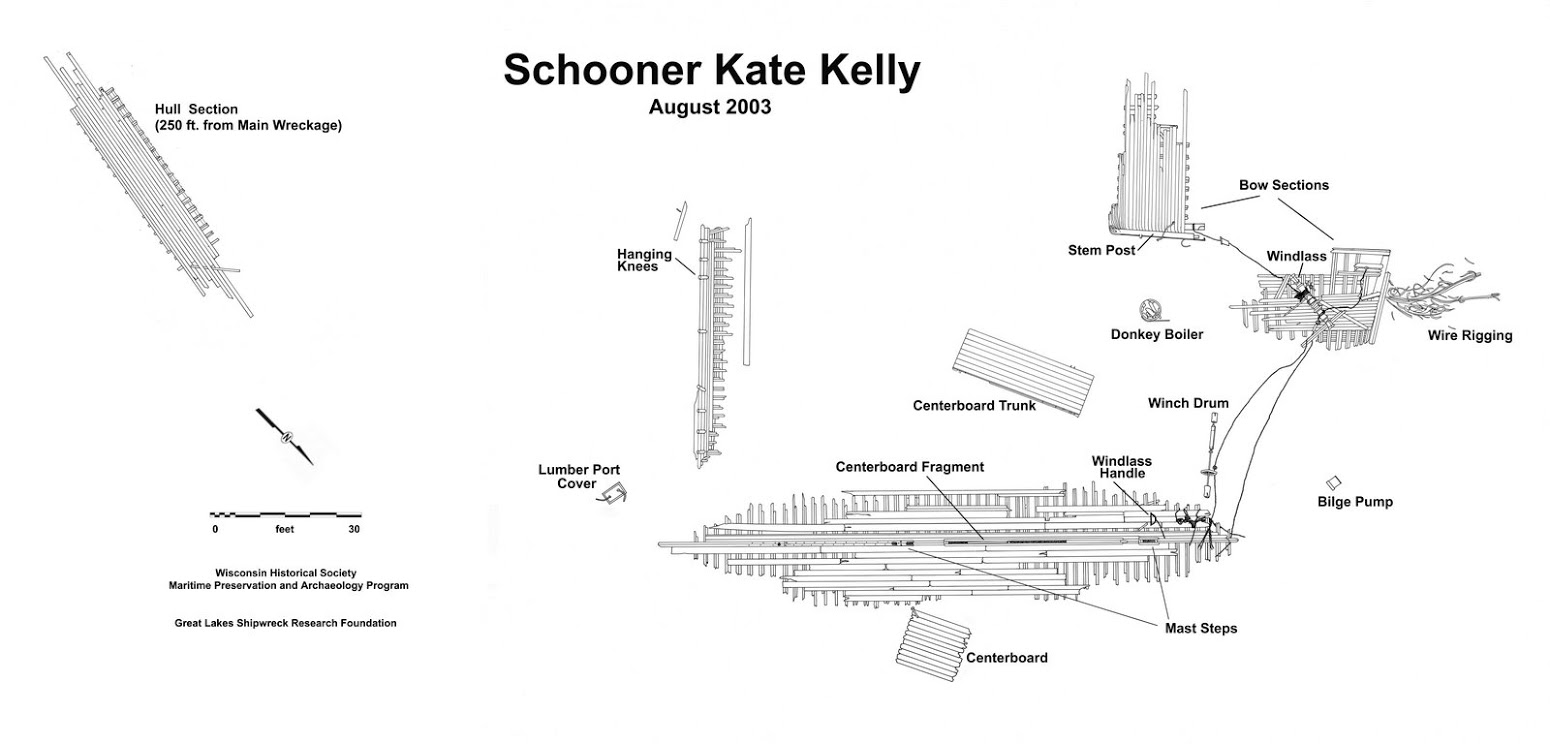
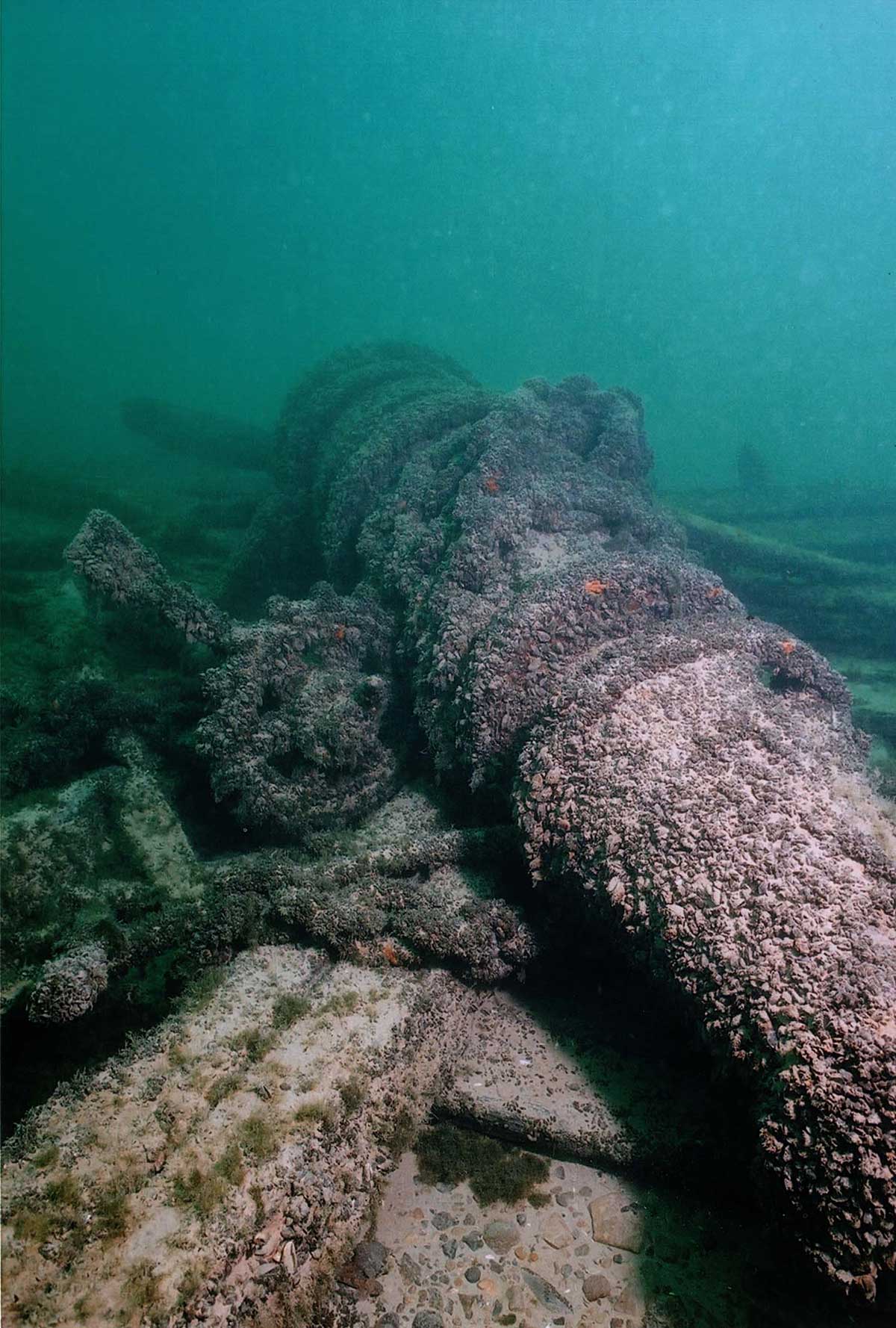
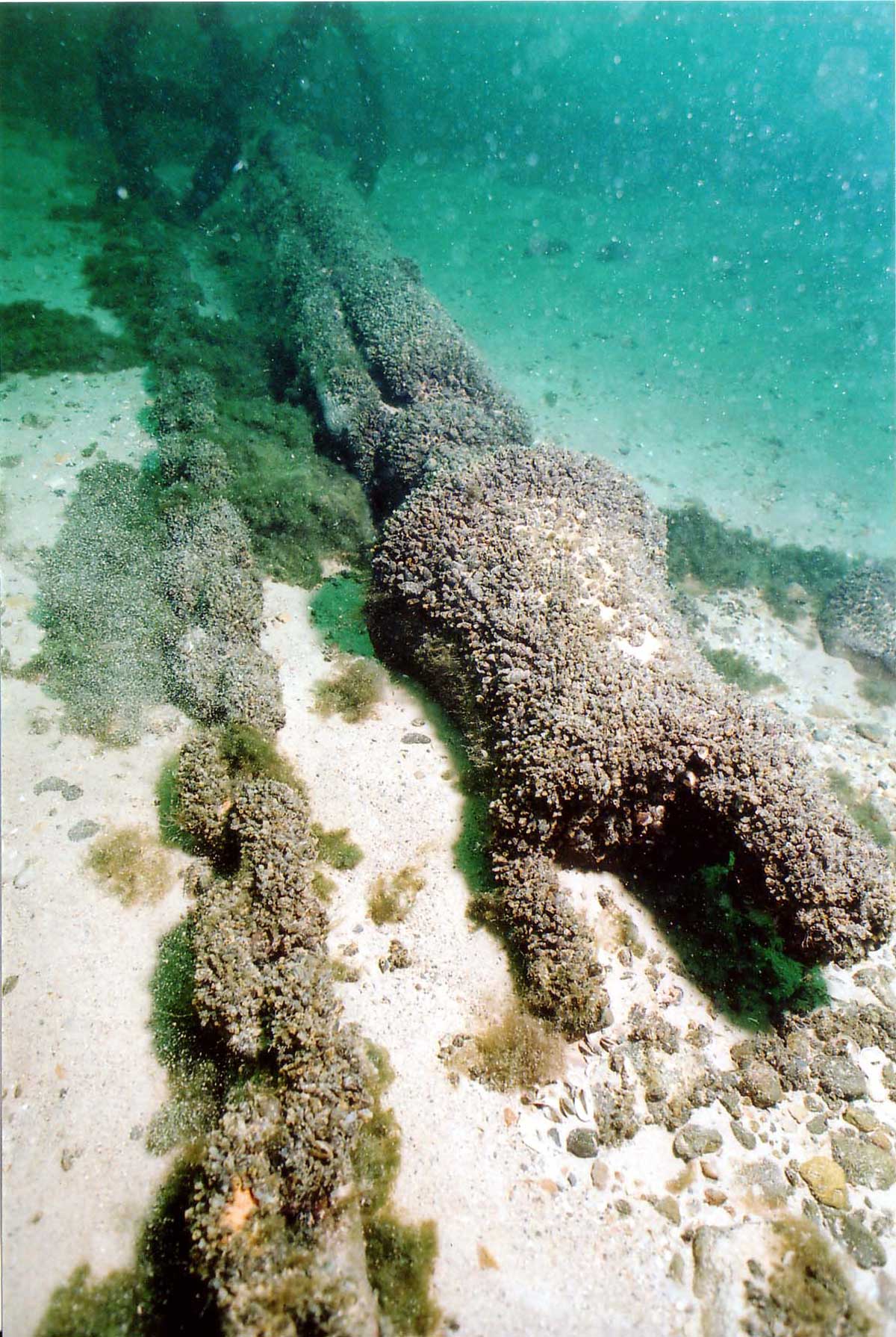
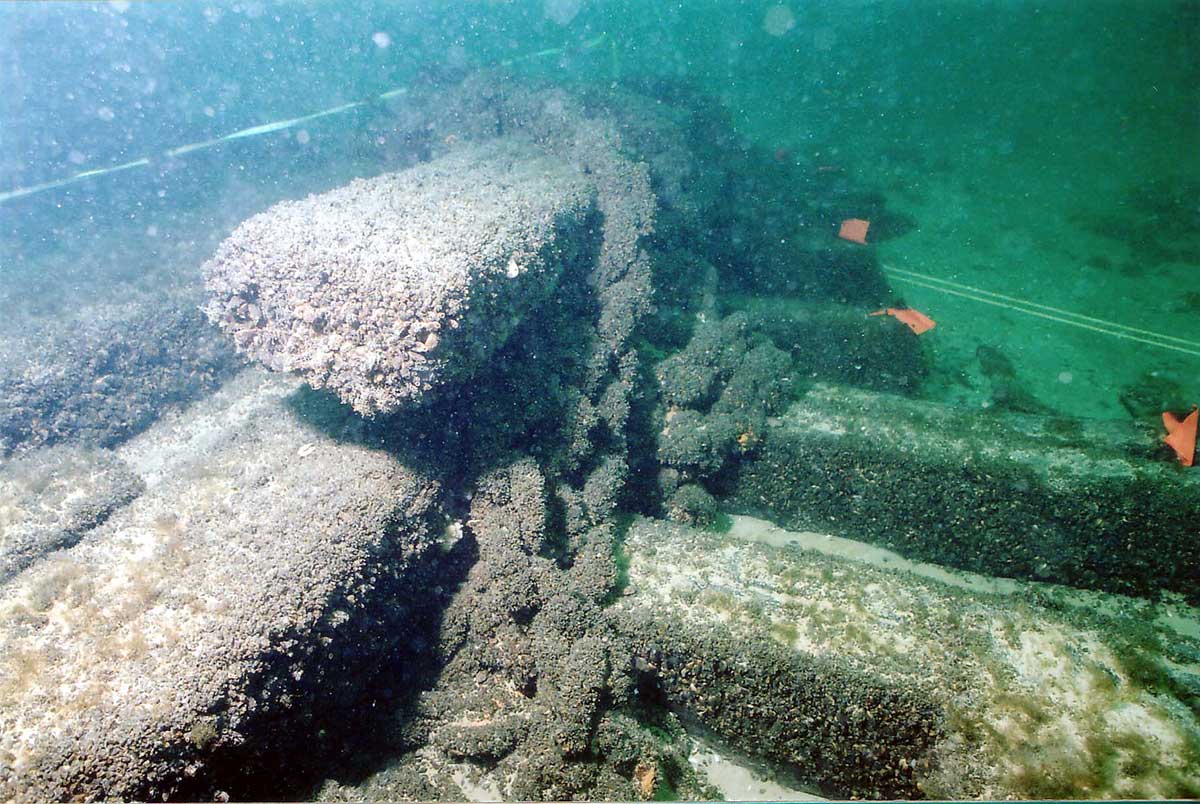
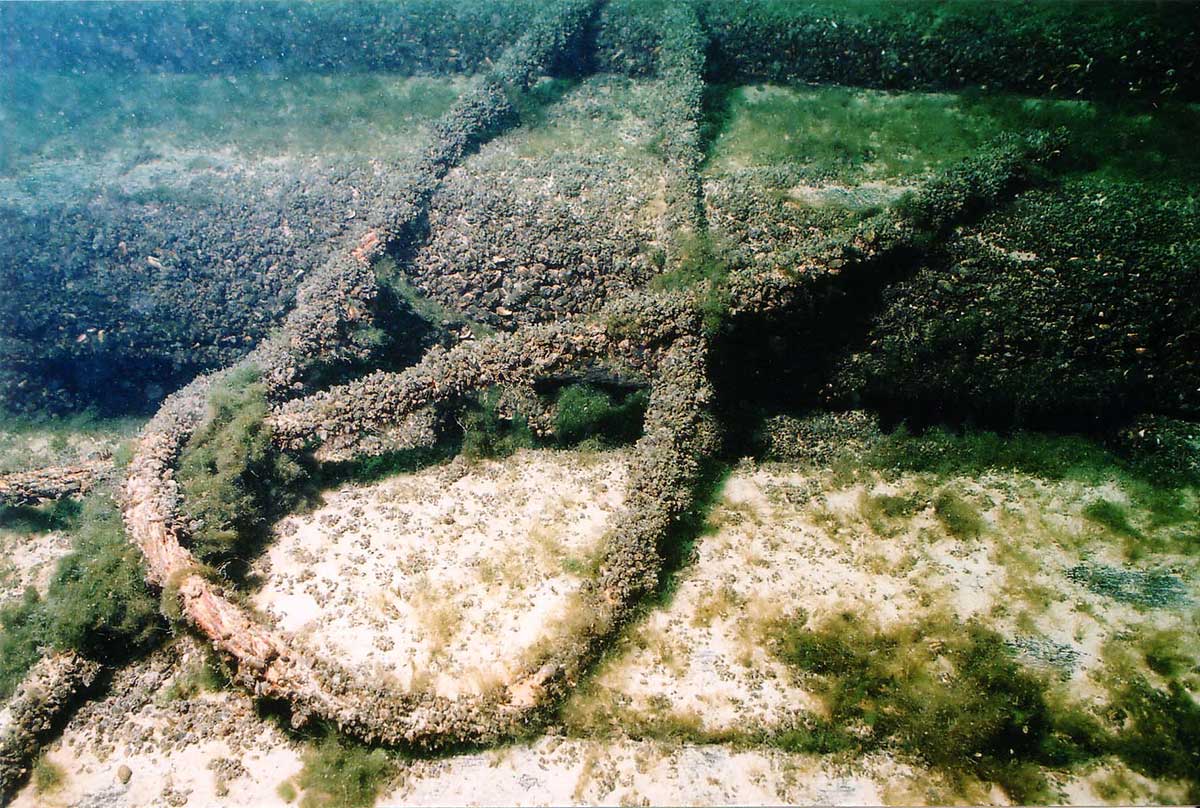
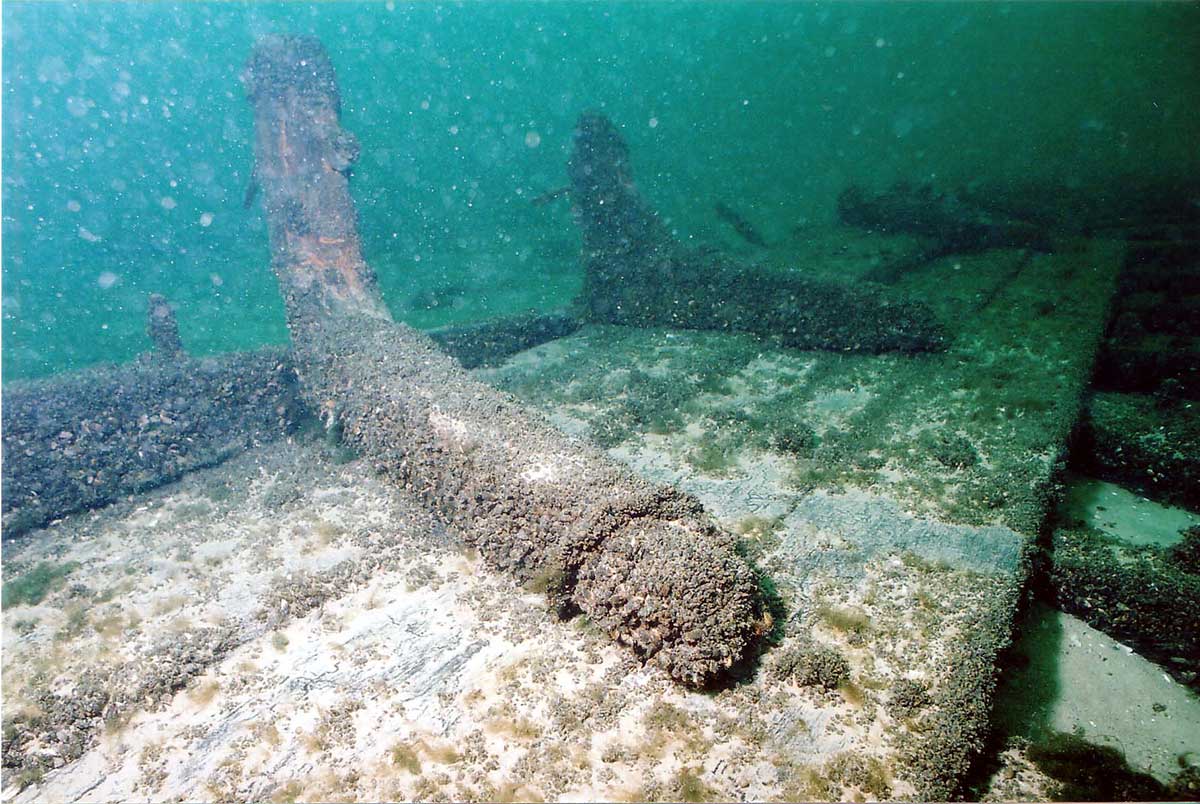

 Confirmed Location
Confirmed Location
 Unconfirmed location
Unconfirmed location